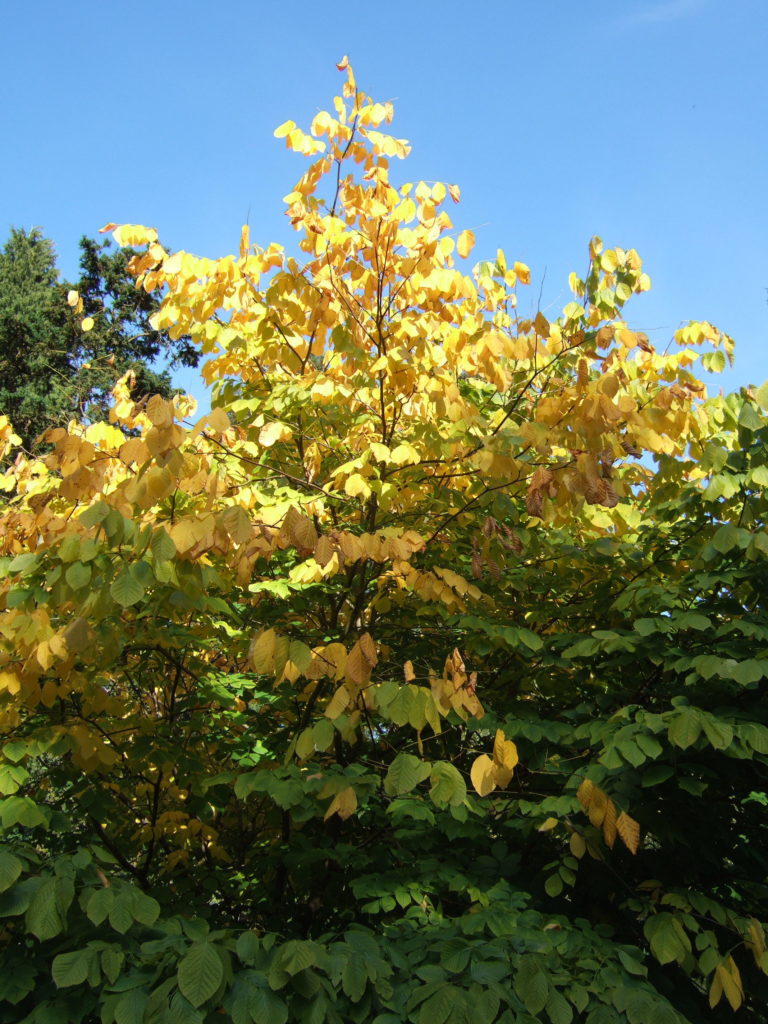In North Carolina, Yellowwood is found only in a few of our western-most counties bordering Tennessee, and is among the rarest of our native trees. It is thirty to fifty feet high and nearly that wide at maturity and is prized as an ornamental for its form, for its smooth, Beech-like bark, pendulous strands of very showy, strongly fragrant, white, leguminous flowers in late spring, and its excellent yellow or orange leaf coloration which it often – but not always – shows in the fall. An important feature is its low-branching form, with zigzag stems, but pruning is recommended in early years to improve a tendency for poor branch angle development. The tree will flower when 8-10 years old, with a spectacular display, and will flower heavily every second or third season thereafter. Yellowwood grows at a medium rate and is tolerant of wide pH range. It is deeply rooted (& drought tolerant). It is named for the color of its freshly cut wood. Yellowwood won a Pennsylvania Horticultural Society Gold Award in 1994. And, the Society of Municipal Arborists selected Yellowwood as its Urban Tree of the Year for 2015.
NURSERY HOURS
Wednesday: 10-4 Thursday: 10-6 Friday-Saturday: 10-4 Sunday: 12-4
Cladrastis kentukea

Key Info
Scientific Name: Cladrastis kentukea (Dumont de Courset) Rudd
Common Names: Kentucky Yellow Wood, Yellow Wood, Gopherwood, Virgillia
Family Names: Fabaceae (Legume or Pea Family)
Plant Type: Tree / Shrub
Leaf Retention: Deciduous
Flower Color: White
Special Characteristics: Fixes atmospheric nitrogen, Tolerates drought, Showy fruit, Flowers fragrant, Attracts butterflies, Tolerates urban pollution, Good fall color, Attracts birds, Slow growing
Additional Info
Habit: A relativly small tree with wide graceful crown, smooth, Beech-like bark on adult trees; roots are deep, allowing strong growth of shade tolerant plants below.
Height: up to 50'
Spread: 40'-50'
Soil Conditions: Moist, well-drained soil, acid to alkaline, a range of textures, sandy, loamy, or clay.
Leaves: The leaves are compound, with 5-11 (mostly 7-9) alternately arranged leaflets. Each leaflet is oval with a pointy tip, with pinnate venation, smooth margins and fuzzy underneath. In the fall, the leaves turn shades of yellow, gold and orange.
Flowers (or reproductive structures: Perfect, creamy white, fragrant, borne in drooping panicles twelve to fourteen inches long, five to six inches broad, at the ends of branches. Flower heavily every 2-3 years.
Fruit: The fruit is a legume (bean like), with 4-6 dark brown seeds.
Natural Distribution: Mesic woods and ravines; limestone cliffs of Kentucky, Tennessee and North Carolina
USDA Hardiness Zone: 4 to 9
USDA Wetland Indicator Status in NC: Not available
Pollination: Probably long-tongued bees
Wildlife Connections: Little is known about floral-faunal relationships for this rare tree. There is some evidence that an overpopulation of White-Tailed Deer can contribute to the decline of Yellow-Wood in protected natural areas (Illinoiswildflowers.info)
Propagation: By seed.
